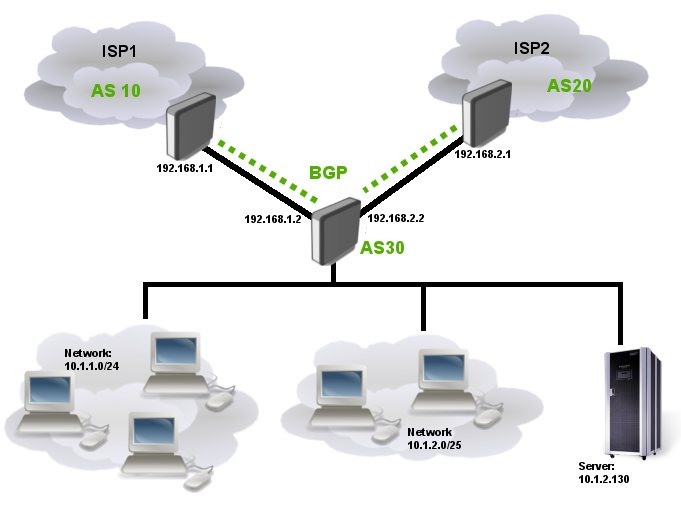Quagga: BGP Sederhana - dengan MD5 Authentication
Jump to navigation
Jump to search
Ada tiga (3) ISP
ISP1:
IP 192.168.1.1/24 menuju ISP3 IP 192.168.3.1/24 menuju ISP2 AS 10 IP 10.100.100.0/24 IP 10.100.200.0/24
ISP2
IP 192.168.2.1/24 - menuju ISP3 IP 192.168.3.2/24 - menuju ISP1 AS 20 IP 10.10.10.0/24 IP 10.10.20.0/24
ISP3 (kita)
IP 192.168.1.2/24 - menuju ISP1 IP 192.168.2.2/24 - menuju ISP2 AS 30 IP 10.1.1.0/24 IP 10.1.2.0/24
Sambungan Fisik
ISP1
ISP1 eth0 -> ISP3 eth0 ISP1 eth1 -> ISP2 eth1 ISP2 eth0 -> ISP3 eth1 ISP1 eth2 10.100.100.1/24 ISP1 eth3 10.100.200.1/24 ISP2 eth2 10.10.10.1/24 ISP2 eth3 10.10.20.1/24 ISP3 eth2 10.1.1.1/24 ISP3 eth3 10.1.2.1/24
Setup connection
ISP1
vtysh
configure terminal
interface eth0
ip address 192.168.1.1/24
no shutdown
exit
interface eth1
ip address 192.168.3.1/24
no shutdown
exit
interface eth2
ip address 10.100.100.1/24
no shutdown
exit
interface eth3
ip address 10.100.200.1/24
no shutdown
exit
end
ISP2
vtysh
configure terminal
interface eth0
ip address 192.168.2.1/24
no shutdown
exit
interface eth1
ip address 192.168.3.2/24
no shutdown
exit
interface eth2
ip address 10.10.10.1/24
no shutdown
exit
interface eth3
ip address 10.10.20.1/24
no shutdown
exit
end
ISP3
vtysh
configure terminal
interface eth0
ip address 192.168.1.2/24
no shutdown
exit
interface eth1
ip address 192.168.2.2/24
no shutdown
exit
interface eth2
ip address 10.1.1.1/24
no shutdown
exit
interface eth3
ip address 10.1.2.1/24
no shutdown
exit
end
BGP Peering
Consider that IP connectivity between ISPs edge routers and Our Core router is already set up and working properly. So we can start to establish BGP peering to both ISPs.
ISP1:
vtysh
configure terminal
router bgp 10
bgp router-id 192.168.1.1
no synchronization
bgp log-neighbor-changes
! address-family ipv4 unicast
network 10.100.100.0/24
network 10.100.200.0/24
neighbor 192.168.3.2 remote-as 20
neighbor 192.168.3.2 password $AP7i1
neighbor 192.168.1.2 remote-as 30
neighbor 192.168.1.2 password $AP7i1
end
ISP2:
vtysh
configure terminal
router bgp 20
bgp router-id 192.168.2.1
no synchronization
bgp log-neighbor-changes
network 10.10.10.0/24
network 10.10.20.0/24
neighbor 192.168.3.1 remote-as 10
neighbor 192.168.3.1 password $AP7i1
neighbor 192.168.2.2 remote-as 30
neighbor 192.168.2.2 password $AP7i1
end
ISP3:
enable
configure terminal
router bgp 30
bgp router-id 192.168.1.2
no synchronization
bgp log-neighbor-changes
network 10.1.1.0/24
network 10.1.2.0/24
neighbor 192.168.1.1 remote-as 10
neighbor 192.168.1.1 password $AP7i1
neighbor 192.168.2.1 remote-as 20
neighbor 192.168.2.1 password $AP7i1
end
Cek
show ip route show ip bgp 10.100.1000.0/24 show ip bgp neighbors 192.168.2.2 advertised-routes show ip bgp neighbor 192.168.1.1 routes show bgp ipv4 unicast neighbors show bgp ipv4 unicast summary
Referensi
- https://www.cisco.com/c/en/us/td/docs/ios-xml/ios/iproute_bgp/configuration/xe-16/irg-xe-16-book/configuring-a-basic-bgp-network.html
- https://wiki.mikrotik.com/wiki/Manual:Simple_BGP_Multihoming
